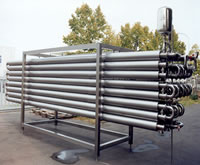- NAVIGATIONS
- Shell & Tube Heat Exchanger
- U Tube Bundle Heat Exchanger
- Air Cooled Heat Exchanger
- Air Cooled Condenser
- Oil Coolers
- Marine Heat Exchanger
- Kettle Reboiler Type Exchanger
- Double Pipe Heat Exchanger
- Flue Gas Air Preheater
- Plate Finned Heat Exchanger
- Plate Heat Exchanger
- Brazed Plate Heat Exchanger
- Pressure Vessel
- Coil Type Heat Exchanger
- Removable Tube Sheet
- Fixed Tube Sheet
- Tube Bundle Heat Exchanger
- Vertical Shell Tube
- Air Heat Exchanger
- Aluminium Heat Exchanger
- Compact Heat Exchanger
- Copper Heat Exchanger
- Water Heat Exchanger
- Stainless Steel
- Heat Exchanger Manufacturers
- Enquiry
- Products
- Plate Type Heat Exchanger Sitemap
Double Pipe Heat Exchanger
Double Pipe Heat Exchanger is a hairpin heat exchanger may have only one inside pipe, it may have multiple inside tubes, but it will always have the doubling back feature shown. Some heat exchanger manufacturers advertise the availability of finned tubes in a hairpin & double pipe heat exchanger.
Double Pipe Heat Exchanger would always be longitudinal fins, than the more common radial fins used in a crossflow finned tube heat exchanger. A double pipe heat exchanger, in its simplest form is just pipe inside another larger pipe.Double Pipe Heat Exchanger flows through the annulus between the two pipes. The wall of the inner is the heat transfer surface. The pipes are usually doubled back multiple times as shown in the diagram at the left, in order to make the overall more compact. The term 'hairpin heat exchanger' is also used for a heat exchanger of the configuration in the diagram.
Types of Double Pipe Heat Exchangers :-
1. Counter flow
2. Parallel Flow Heat Exchanger
1. Counter flow:-
The main advantage of a double pipe heat exchanger is that it can be operated in a true counter flow pattern, To get More Efficiency, it will give the highest overall heat transfer coefficient for the double pipe heat exchanger design.
2. Parallel Flow :
Double pipe heat exchangers are focused to handle high pressures and temperatures applications. Also we can Achieve High Log mean Temperature using this.
3. Double Pipe Heat Exchanger Design :
Determination of the heat transfer surface area needed for a double pipe heat exchanger design can be done using the basic heat exchanger equation: Q = UA ?Tlm, where: Q is the rate of heat transfer between the two fluids in the heat exchanger in Btu/hr, U is the overall heat transfer coefficient in BTU/hr-ft2-oF, A is the heat transfer surface area in ft2, and ?Tlm is the log mean temperature difference, calculated from the inlet and outlet temperatures of both fluids. These parameters in the basic heat exchanger equation are discussed, After determination of the required heat transfer surface area, the diameter and length of the inner pipe can be selected and then the diameter of the outer pipe. Finally, the length of the straight sections and the number of bends can be selected.
- Double Pipe Heat Exchanger are operating in true counterflow, they can operate with a temperature cross, that is, where the cold side outlet temperature is higher than the hot side outlet temperature.
- Double Pipe Heat Exchanger will give the highest overall heat transfer coefficient for the double pipe heat exchanger design. Also, hairpin and double pipe heat exchangers can handle high pressures and temperatures well.
- A primary advantage of a hairpin or double pipe heat exchanger is that it can be operated in a true counterflow pattern, which is the most efficient flow pattern.



